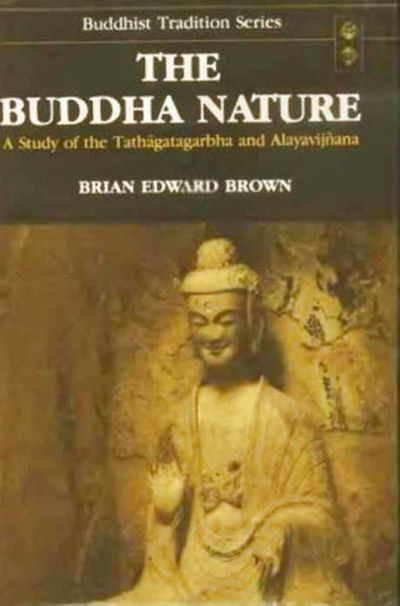The Buddha Nature: A Study of the Tathāgatagarbha and Ālayavijñāna
< Books
| Line 50: | Line 50: | ||
** {{i|Evaluation|171}} | ** {{i|Evaluation|171}} | ||
* {{i|Part Two|}} | * {{i|Part Two|}} | ||
| − | * {{i|The ''Ālayalavijñāna'' in the '' | + | * {{i|The ''Ālayalavijñāna'' in the ''Laṅkāvatāra Sūtra'' and the ''Ch'eng Wei-Shih Lun''|}} |
| − | * {{i|VIII. The '' | + | * {{i|VIII. The ''Laṅkāvatāra Sūtra''|179-194}} |
** {{i|The Union of the ''Tathāgatagarbha'' and the ''Ālayavijñana''|179}} | ** {{i|The Union of the ''Tathāgatagarbha'' and the ''Ālayavijñana''|179}} | ||
| − | ** {{i|The Confusion of Epistemology and Ontology in the '' | + | ** {{i|The Confusion of Epistemology and Ontology in the ''Laṅkāvatāra''|185}} |
* {{i|IX. The Ch'eng Wei-Shih Lun|'''195-211'''}} | * {{i|IX. The Ch'eng Wei-Shih Lun|'''195-211'''}} | ||
** {{i|The Metaphysics of Mere-Consciousness|195}} | ** {{i|The Metaphysics of Mere-Consciousness|195}} | ||
| Line 72: | Line 72: | ||
** {{i|The ''Tathāgatagarbha'' in the ''Śrī-Mālā Sūtra''|247}} | ** {{i|The ''Tathāgatagarbha'' in the ''Śrī-Mālā Sūtra''|247}} | ||
** {{i|The ''Tathāgatagarbha'' in the ''Ratnagotravibhāga''|251}} | ** {{i|The ''Tathāgatagarbha'' in the ''Ratnagotravibhāga''|251}} | ||
| − | ** {{i|The '' | + | ** {{i|The ''Laṅkāvatāra Sūtra''|260}} |
** {{i|The ''Ch'eng Wei-Shih Lun''|263}} | ** {{i|The ''Ch'eng Wei-Shih Lun''|263}} | ||
** {{i|The Ultimate Status of Ignorance in the Theory of the ''Tathāgatagarbha-Ālayavijñāna''|266}} | ** {{i|The Ultimate Status of Ignorance in the Theory of the ''Tathāgatagarbha-Ālayavijñāna''|266}} | ||
Latest revision as of 18:11, 9 October 2020
One of the fundamental tenets of Mahayana Buddhism animating and grounding the doctrine and discipline of its spiritual path, is the inherent potentiality of all animate beings to attain the supreme and perfect enlightenment of Buddhahood. This book examines the ontological presuppositions and the corresponding soteriological-epistemological principles that sustain and define such a theory. Within the field of Buddhist studies, such a work provides a comprehensive context in which to interpret the influence and major insights of the various Buddhist schools. Thus, the dynamics of the Buddha Nature, though non-thematic and implicit, is at the heart of Zen praxis, while it is a significant articulation in Kegon, Tendai, and Shingon thought. More specifically, the book seeks to establish a coherent metaphysics of absolute suchness (Tathatā), synthesizing the variant traditions of the Tathagata-embryo (Tathāgatagarbha) and the Storehouse Consciousness (Ālayavijñāna).
The book's contribution to the broader field of the History of Religions rests in its presentation and analysis of the Buddhist Enlightenment as the salvific-transformational moment in which Tathatā 'awakens' to itself, comes to perfect self-realization as the Absolute suchness of reality, in and through phenomenal human consciousness. The book is an interpretation of the Buddhist Path as the spontaneous self-emergence of 'embryonic' absolute knowledge as it comes to free itself from the concealments of adventitious defilements, and possess itself in fully self-explicitated self-consciousness as the 'Highest Truth' and unconditional nature of all existence; it does so only in the form of omniscient wisdom. (Source: Book jacket inside cover)
| Citation | Brown, Brian Edward. The Buddha Nature: A Study of the Tathāgatagarbha and Ālayavijñāna. Buddhist Tradition Series 11. Delhi: Motilal Banarsidass, 1991. https://archive.org/details/tathagatgarbhabuddhanatureastudyofthetathagatagarbhaandalayavijnanabrianedwardbr/mode/2up. |
|---|---|


